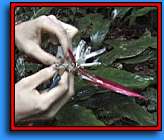| Plant Seeking....Plant
Now how does a nice California guy find himself “Love Doctor” to plants in the Amazon Rainforest?
“I’m trying to see what role nutrients play, and so I’m experimenting by first pollinating plants, and then fertilizing them, to see how the plants do. I keep tabs on the plants, note if there are flowers and if so, the size and number of flowers produced.” Like many rainforest researchers, Emilio is interested in the interactions between different organisms in the forest; his interest is not one specific animal or plant, but the overall field of ecology. “I’m interested in what can be learned about understory plants in general from the example of the heliconia, what can be learned about the interactions between the plants, pollinators, seed dispersers, and herbivores. I like to use heliconia because it’s one of the most common plants in the understory. It’s also a very important plant because with its abundant flowers, it is a primary food source for hummingbirds.”
|
| Emilio’s Interview/Journals | Plant Seeking....Plant 1 2 3 |
![]()
 “Ok, ok, I’m into plant romance,” says Emilio Bruna.
“Ok, ok, I’m into plant romance,” says Emilio Bruna.
 “I’m interested in how the
“I’m interested in how the